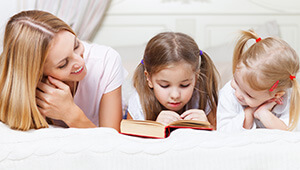The Power of Storytime


Reading aloud to your child is a priceless family ritual that can offer solace, strength, and joy as well as bring balance to your family’s hectic life. A child is never too young for a shared story. So don’t make reading time a “have to.” Make it a “want to.”
It may sound strange to talk about reading to an infant who can’t even sit up on her own yet or one who prefers gumming the pages of a book to turning them. However, experts say that reading to the very young is the best way to forge a lasting bond. Snuggled in your arms, your infant thrives on the melody and modulation of your voice. In fact, it’s the musical nature of language, the rhythm of prose, that compels a child to pay attention to a story even though she may be years away from understanding the meaning of the words.
“Usually when we read, we speak in a calm, soothing, welcoming tone,” notes Melanie A. Katzman, Ph.D., associate clinical professor in psychiatry at Weill Cornell Medical School in New York City. In time, your baby begins to associate the experience of reading with a special one-on-one closeness.
“Reading at this age is less about specific aspects of child development than it is about developing a relationship between child, parent, and books,” adds Kyle Snow, Ph.D., director of the Early Learning and School Readiness program at the National Institute of Child Health and Human Development (NICHD). “Reading to an infant sets the foundation for a habit. The child learns that every day a parent will hold her and give her undivided attention.”
It also provides an opportunity to pick up on your child’s unique cues. “As you hold her close, you’ll begin to notice what she’s looking at, what excites her, when she’s tired,” Snow says. “You’ll start to figure out how to use your own voice to better connect with your child, and the physical closeness further enhances feelings of security.” During the first year, your baby may begin babbling her own streams of sounds that mimic what she hears. When you respond, she learns that language connects one person to another. So prop your baby on your lap and get going.
- Surround her with words.Read nursery and nonsense rhymes, play pat-a-cake and “this little piggy” – silly games with repetitive patterns that link words to gestures or objects. Flip through brightly colored picture books of familiar objects and make up a story as you go along. Don’t forget to listen to tapes and CDs. And sing! Even the tone-deaf can muster a spirited rendition of “Row, Row, Row Your Boat” or “Twinkle, Twinkle Little Star.” Continue the banter as you go about your day. By age two, your child will have a storehouse of words in her mind – she’ll understand many more than she can actually say.
- Make reading a regular part of your baby’s routine.In this way, it becomes a special moment that your child – and you – can look forward to. Babies absorb far more from story time than most parents imagine. They learn how to hold a book; that books are read from left to right; and, eventually, that those funny marks on the page actually mean something. You can make reading a family ritual before a nap or after lunch or a bath. Take your child into your bed in the morning and cuddle with a book.
- Buy soft cloth or waterproof books with bright colors, simple shapes, and familiar objects.Highly detailed illustrations can be overwhelming to a baby, but you’ll grab her attention with animals, vehicles, and people in real-life situations, such as a fireman, policeman, or Mommy and Daddy at the office. One-word-per-page books will eventually help her expand her vocabulary. Books with textured pages stimulate a child’s visual sense and lend a tactile dimension to story time. If she’s old enough, let her turn the pages. Interactive books, with flaps that lift up or pull down to reveal little surprises, delight and draw kids further into the process. As you read, guide your child by pointing to the pictures and saying the names of the various objects out loud. Ask questions, even if you carry on a conversation with yourself: “Where’s the doggie? He’s under the bed!” “That’s a cow. What sound does a cow make? A cow says m-o-o-o!”
- Reinforce what your child is learning as she gets older.Your toddler may pick up a book and pretend to read or may even begin to recognize letters and numerals. Have fun with words by making up silly rhymes, songs or chains of words beginning with the same letter. A shared laugh anchors a memory.
- Fill your home with books.Keep some in the car and some waterproof ones in the bathroom. Let your toddler see you reading, and talk about books you love so she learns how much you value them.
- Take advantage of local reading programs.Most libraries or community centers offer programs for young children that augment the experience of reading with puppet shows, films, or crafts. Spending time together engaged in reading-related activities gives you another way to stay close.
Children of readers are much more likely to read themselves. Those who have come to associate reading with the warmth and comfort of being curled up next to you will grow up cherishing books and their connection to you.


